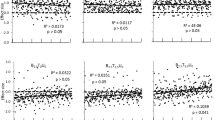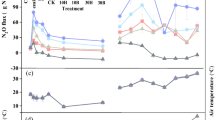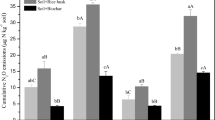Abstract
The application of biochar can affect the nitrous oxide (N2O) emissions from soil. Although laboratory studies reported that biochar applications can reduce N2O emissions, the number of field-based studies is still limited. Therefore, in the present study, we investigated the effects of four different types of biochars and their interactions with a variety of environmental parameters on N2O emissions from an Andosol field over a 2-year period (2015–2016). The field experiment consisted of five treatments: chemical (mineral) fertilizer without biochar (CF), chemical fertilizer with rice husk biochar (RH), chemical fertilizer with chipped bamboo biochar (BA), chemical fertilizer with chipped hardwood biochar (HW), and chemical fertilizer with chipped wood briquette biochar made from a mixture of softwood and hardwood sawdust (SH). Biochar was applied at a rate of 25 t ha−1. The NH4+–N and NO3−–N adsorption capacity of biochars before application was also measured. NH4+–N adsorption capacity differed among the biochars, while biochars showed very little NO3−–N absorption capacity. The cumulative N2O emission of biochar treatment to that of the CF treatment during the N2O peak period (17 days) after biochar and fertilizer application increased with the increase of NH4+–N adsorption capacity of the biochar. However, biochar application did not affect the cumulative N2O emission over 2 years in the field condition. The lack of significant differences may have been due to Andosol CEC (31.3 cmol(+) kg−1), which was higher than that of the biochars (4.52–19.65 cmol(+) kg−1), and also high pH-buffering capacity of Andosol.




Similar content being viewed by others
References
Ahmad M, Rajapaksha AU, Lim JE, Zhang M, Bolan N, Mohan D, Vithanage M, Lee SS, Ok YS (2014) Biochar as a sorbent for contaminant management in soil and water: a review. Chemosphere 99:19–33
Akiyama H, Tsuruta H (2002) Effect of chemical fertilizer form on N2O, NO and NO2 fluxes from Andisol field. Nutr Cycl Agroecosyst 63:219–230
Akiyama H, Tsuruta H (2003) Effect of organic matter application on N2O, NO, and NO2 fluxes from an Andisol field. Global Biogeochem Cycles 17:1100. https://doi.org/10.1029/2002gb002016
Akiyama H, Tsuruta H, Watanabe T (2000) N2O and NO emissions from soils after the application of different chemical fertilizers. Chemosphere Global Change Sci 2:313–320
Akiyama H, Hayakawa A, Sudo S, Yonemura S, Tanonaka T, Yagi K (2009) Automated sampling system for long-term monitoring of nitrous oxide and methane fluxes from soils. Soil Sci Plant Nutr 55:435–440
Akiyama H, Yan X, Yagi K (2010) Evaluation of effectiveness of enhanced-efficiency fertilizers as mitigation options for N2O and NO emissions from agricultural soils: meta-analysis. Global Change Biol 16:1837–1846
American Society for Testing and Materials (ASTM) (2007) Standard test method for chemical analysis of wood charcoal. ASTM D1762-84. ASTM International, West Conshohocken, PA
Angst TE, Patterson CJ, Reay DS, Anderson P, Peshkur TA, Sohi SP (2013) Biochar diminishes nitrous oxide and nirate leaching from diverse nutrient sources. J Environ Qual 42:672–682
Aran D, Gury M, Jeanroy E (2001) Organo-metallic complexes in an Andosol: a comparative study with a Cambisol and Podzol. Geoderma 99:65–79
Baba M, Okazaki M, Hashitani T (1995) Effect of acidic deposition on forested Andisols in the Tama hill region of Japan. Environ Pollut 89:97–106
Baggs EM, Philippot L (2010) Microbial terrestrial pathways to nitrous oxide. In: Smith K (ed) Nitrous oxide and climate change. Earthscan, London, pp 4–35
Basche AD, Miguez FE, Kaspar TC, Castellano MJ (2014) Do cover crop increase or decrease nitrous oxide emissions? A meta-analysis. J Soil Water Conserv 69:471–482
Brunauer S, Emmett PH, Teller E (1938) Adsorption of gases in multimolecular layers. J Am Chem Soc 60:309–319
Butnan S, Deenik JL, Toomsan B, Antal MJ, Vityakon P (2016) Biochar properties influencing greenhouse gas emissions in tropical soils differing in texture and mineralogy. J Environ Qual 45:1509–1519
Cai Y, Qi H, Liu Y, He X (2016) Sorption/desorption behavior and mechanism of NH4 + by biochar as a nitrogen fertilizer sustained-release material. J Agric Food Chem 64:4958–4964
Case SDC, McNamara NP, Reay DS, Stott AW, Grant HK, Whitaker J (2015) Biochar suppresses N2O emissions while maintaining N avairability in a sandy loam soil. Soil Biol Biochem 81:178–185
Castaldi S, Riondino M, Baronti S, Esposito FR, Marzaioli R, Rutigliano FA, Vaccari FP, Miglietta F (2011) Impact of biochar application to a Mediterranean wheat crop on soil microbial activity and greenhouse gas fluxes. Chemosphere 85:1454–1471
Cayuela ML, Sánchez-Monedero MA, Roig A, Hanley K, Enders A, Lehmann J (2013) Biochar and denitrification in soils: when, how much and why does biochar reduce N2O emissions? Sci Rep 3–1732:1–7
Cayuela ML, van Wieten L, Singh BP, Jeffery S, Roig A, Sánchez-Monedero MA (2014) Biochar’s role in mitigating soil nitrous oxide emissions: a review and meta-analysis. Agric Ecosyst Environ 191:5–16
Cayuela ML, Jeffery S, van Zwieten L (2015) The molar H: corg of biochar is a key factor in mitigating N2O emissions from soil. Agric Ecosyst Eviron 202:135–138
Claoston N, Samsuri AW, Husni MHA, Amran MSM (2014) Effects of pyrolysis temperature on the physicochemical properties of empty fruit bunch and rice husk biochars. Waste Manag Res 32:331–339
Clough TJ, Bertram JE, Ray JL, Condron LM, Callaghan MO, Sherlock RR, Wells NS (2010) Unweathered wood biochar impact on nitrous oxide emissions from a bovine-urine-amended pature soil. Soil Sci Soc Am J 74:852–860
Edenhofer O, Pichs-Madruga R, Sokona Y, Minx JC, Farahani E, Kandner S, Seyboth K, Adler A, Baum I, Brunner S, Eickemeier P, Kriemann B, Savolainen J, Schlómer S, von Stechow C, Zwickel T (2014) Climate change 2014: mitigation of climate change: working group III contribution to the Fifth Assessment Report of the intergovermental panel on climate change. Cambridge University Press, Cambridge
Enders A, Hanley K, Whitman T, Joseph S, Lehmann J (2012) Characterization of biochars to evaluate recalcitrance and agronomic performance. Bioresour Technol 114:644–653
Feng Z, Zhu L (2017) Impact of biochar on soil N2O emissions under different biochar-carbon/fertilizer-nitrogen ratios at a constant moisture condition on a silt loam soil. Sci Total Environ 584–585:776–782
Foo KY, Hameed BH (2010) Insights into the modeling of adsorption isotherm systems. Chem Eng 156:2–10
Gai X, Wang H, Liu J, Zhai L, Liu S, Ren T, Liu H (2014) Effects of feedstock and pyrolysis temperature on biochar adsorption of ammonium and nitrate. PLoS ONE 3:1–19
Grandy AS, Loecke TD, Parr S, Robertson GP (2006) Long-term trends in nitrous oxide emissions, soil nitrogen, and crop yields of till and no-till cropping systems. J Environ Qual 35:1487–1495
Granli T, Bøckman OC (1994) Nitrous oxide from agriculture. Nor J Agric Sci 12:7–127
Guicharnaud R, Paton GI (2006) An evaluation of acid deposition on cation leaching and weathering rates of an Andosol and a Cambisol. J Geochem Explor 88:279–283
Hale SE, Alling V, Martinsen V, Mulder J, Breedveld GD, Cornelissen G (2013) The sorption and desorption of phosphate-P, ammonium-N and nitrate-N in cacao shell and corn cob biochars. Chemosphere 91:1612–1619
Harter J, Krause HM, Schuettler S, Ruser R, Fromme M, Scholten T, Kappler A, Behrens S (2014) Linking N2O emissions from biochar-amended soil to the structure and function of N-cycling microbial community. ISME J 8:660–674
Hosen Y, Tsuruta H, Minami K (2000) Effects of the depth of NO and N2O productions in soil on their emission rates to the atmosphere: analysis by a simulation model. Nutr Cycl Agroecosyst 57:83–98
Hu HW, Chen D, He JD (2015) Microbial regulation of terrestrial nitrous oxide formation: understanding the biological pathways for prediction of emission rate. FEMS Microbiol Rev 39:729–749
Kameyama K, Miyamoto T, Shiono T, Shinogi Y (2012) Influence of sugarcane bagasse-derived biochar application on nitrate leaching in calcaric dark red soil. J Environ Qual 41:1131–1137
Koga N, Shimoda S, Iwata Y (2017) Biochar impact on crop productivity and greenhouse gas emissions from an Andosol. J Environ Qual 46:27–35
Laird D, Fleming P, Wang B, Horton R, Karlen D (2010) Biochar impact on nutrient leaching from a Midwestern agricultural soil. Geoderma 158:436–442
Langmuir I (1916) The constitution and fundamental properties of solids and liquids Part I solids. J Am Chem Soc 38:2221–2295
Liu P, Liu WJ, Jiang H, Chen JJ, Li WW, Yu HQ (2012) Modification of bio-char derived from fast pyrolysis of biomass and its application in removal of tetracycline from aqueous solution. Bioresour Technol 121:235–240
Liu Q, Liu B, Zhang Y, Lin Z, Zhu T, Sun R, Wang X, Ma J, Bei Q, Liu G, Lin X, Xie Z (2017) Can biochar alleviate soil compaction stress on wheat growth and mitigate soil N2O emissions? Soil Biol Biochem 104:8–17
Maejima Y, Murano H, Iwafune T, Arao T, Baba K (2011) Adsorption and mobility of aromatic arsenicals in Japanese agricultural soils. Soil Sci Plant Nutr 57:429–435
Mu Z, Huang A, Kimura SD, Jin T, Wei S, Hatano R (2009) Linking N2O emission to soil mineral N as estimated by CO2 emission and soil C/N ratio. Soil Biol Biochem 41:2593–2597
Nguyen TTN, Xu CY, Tahmasbian I, Che R, Xu Z, Zhou X, Wallace HM, Bai SH (2017) Effects of biochar on soil available inorganic nitrogen: a review and meta-analysis. Geoderma 288:79–96
Ok YS, Yang JE, Zhang YS, Kim SJ, Chung DY (2007) Heavy metal adsorption by a formulated zeolite-Portland cement mixture. J Hazard Mater 147:91–96
Ravishankara AR, Daniel JS, Portman RW (2009) Nitrous oxide (N2O): the dominant ozone-depleting substance emitted in the 21st century. Science 326:123–125
Scheer C, Grace PR, Rowlings DW, Kimber S, Zwieten LV (2011) Effect of biochar amendment on the soil-atmosphere exchange of greenhouse gases from an intensive subtropical pasture in northern new south wales, Australia. Plant Soil 345:47–58
Schollenberger CJ, Simon RH (1945) Determination of exchange capacity and exchangeable bases in soils. Soil Sci 59:13–24
Shimotsuma M, Uchida Y, Nakajima Y, Akiyama H (2017) The effects of rice (Oryza sativa L. ssp. Japonica) husk biochar on nitrogen dynamics during the decomposition of hairy vetch in two soils under high-soil moisture condition. Soil Sci Plant Nutr 63:178–184
Singh BP, Hatton BJ, Singh B, Cowie AL, Kathuria A (2010) Influence of biochars on nitrous oxide emission and nitrogen leaching from two contrasting soils. J Environ Qual 39:1224–1235
Sohi SP, Krull E, Lopez-Capel E, Bol R (2010) A review of biochar and its use and function in soil. Adv Agron 105:47–82
Spokas KA (2013) Impact of biochar field aging on laboratory greenhouse gas production potentials. GCB Bioenergy 5:165–176
Spokas KA, Koskinen WC, Baker JM, Reicosky DC (2009) Impacts of woodchip biochar additions on greenhouse gas production and sorption/degradation of two herbicides in a Minnesota soil. Chemosphere 77:574–581
Stocker TF, Qin D, Plattner GK, Tignor MMB, Allen SK, Boschung J, Nauels A, Xia Y, Bex V, Middley PM (2013) Climate change 2013: the physical science basis: contribution of Working Group I to the fifth assessment report of the intergovernmental panel on climate change. Cambridge University Press, Cambridge
Suddick EC, Six J (2013) An estimation of annual nitrous oxide emissions and soil quality following the amendment of high temperature walnut shell biochar and compost to a small scale vegetable crop rotation. Sci Total Environ 465:298–307
Taghizadeh-Toosi A, Clough TJ, Condron LM, Sherlock RR, Anderson CR, Craigie RA (2011) Biochar incorporation into pasture soil suppresses in situ nitorous oxide emissions from ruminant urine patches. J Environ Qual 40:468–476
Taghizadeh-Toosi A, Clough TJ, Sherlock RR, Condron LM (2012a) Biochar adsorbed ammonia is bioavailable. Plant Soil 350:57–69
Taghizadeh-Toosi A, Clough TJ, Sherlock RR, Condron LM (2012b) A wood based low-temperature biochar captures NH3-N generated from ruminant urine-N, retaining its bioavailability. Plant Soil 353:73–84
Takahashi M, Sakata T, Ishizuka K (2001) Chemical characteristics and acid buffering capacity of surface soils in Japanese forests. Water Air Soil Pollut 130:727–732
Takeda H, Takahashi N, Hatano R, Hashidoko Y (2012) Active N2O emission from bacterial microbiota of Andisol farmland and characterization on some N2O emitters. J Basic Microbiol 52:477–486
Wang J, Zhang M, Xiong Z, Liu P, Pan G (2011) Effects of biochar addition on N2O and CO2 emissions from two paddy soils. Biol Fertil Soils 47:887–896
Wells NA, Baggs EM (2014) Char amendments impact soil nitrous oxide production during ammonia oxidation. Soil Sci Soc Am J 78:1656–1660
Yanai Y, Toyota K, Okazaki M (2007) Effects of charcoal addition on N2O emissions from soil resulting from rewetting air-dried soil in short-term laboratory experiments. Soil Sci Plant Nutr 53:181–188
Acknowledgments
We are grateful to Dr. Masako Kajiura and Dr. Yasuhito Shirato (Institute for Agro-Environmental Sciences, Japan) for their assistance with the measurements of biochar properties. This work was supported by JSPS KAKENHI (Grant Nos. 26292184 and 18H02318) and by the Asahi Group Foundation.
Author information
Authors and Affiliations
Corresponding author
Additional information
Publisher's Note
Springer Nature remains neutral with regard to jurisdictional claims in published maps and institutional affiliations.
Electronic supplementary material
Below is the link to the electronic supplementary material.
Rights and permissions
About this article
Cite this article
Yamamoto, A., Akiyama, H., Kojima, M. et al. Nitrous oxide emissions from an Andosol upland field amended with four different types of biochars. Nutr Cycl Agroecosyst 113, 323–335 (2019). https://doi.org/10.1007/s10705-019-09983-2
Received:
Accepted:
Published:
Issue Date:
DOI: https://doi.org/10.1007/s10705-019-09983-2




